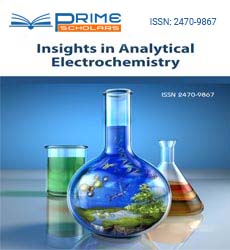Commentary - (2023) Volume 9, Issue 2
Unraveling Mysteries: The Power of Impedance Spectroscopy
Pearson Joseph*
Department of Biochemistry, University Paris-Sud, France
*Correspondence:
Pearson Joseph,
Department of Biochemistry, University Paris-Sud,
France,
Email:
Received: 31-May-2023, Manuscript No. IPAEI-23-17209;
Editor assigned: 02-Jun-2023, Pre QC No. IPAEI-23-17209 (PQ);
Reviewed: 16-Jun-2023, QC No. IPAEI-23-17209;
Revised: 21-Jun-2023, Manuscript No. IPAEI-23-17209 (R);
Published:
28-Jun-2023, DOI: 10.21767/2470-9867-9.2.15
Description
In the realm of scientific exploration, impedance spectroscopy
stands as a versatile and powerful technique that has revolutionized
various fields of study. From materials science to biology
and electrochemistry, this method provides unique insights
into the electrical properties of materials and systems. Impedance
spectroscopy offers a deeper understanding of complex
phenomena and facilitates the development of innovative
solutions. In this commentary article, we delve into the significance
of impedance spectroscopy, its diverse applications, and
the potential it holds for future discoveries.
Impedance spectroscopy is a non-destructive technique that
examines the electrical response of a system to an applied alternating
current (AC). It involves measuring the impedance,
which is the opposition to current flow, as a function of frequency.
By analysing how the system’s impedance varies across
a range of frequencies, researchers gain valuable information
about its underlying electrical properties. This method not only
provides insights into fundamental material characteristics but
also enables the study of complex systems involving chemical
reactions, biological processes, and electronic components.
Impedance spectroscopy has become a cornerstone in materials
science, enabling researchers to explore the electrical behavior
of a wide range of materials, from metals to polymers
and semiconductors. By studying the impedance response,
scientists can determine critical material parameters such as
conductivity, dielectric properties, and charge carrier mobility.
Moreover, impedance spectroscopy at the nanoscale has
contributed significantly to the understanding of interfacial
phenomena in materials, offering insights into charge transfer
and transport mechanisms. The application of impedance
spectroscopy has transcended the boundaries of traditional
physics and chemistry to make its mark in the realm of biology.
In biotechnology and bioengineering, this technique has
proved invaluable in studying cellular activities, including cell
adhesion, migration, and proliferation. With the advent of cellbased
impedance sensors, researchers can now monitor cellular
responses in real-time, providing a deeper understanding of
cellular behaviour and enabling advancements in drug discovery
and toxicity testing.
In electrochemistry, impedance spectroscopy is an indispensable
tool for understanding the kinetics of redox reactions, characterizing
electrode-electrolyte interfaces, and evaluating the
performance of energy storage devices like batteries and fuel
cells. By studying the impedance response of these systems,
researchers can identify limiting factors and design strategies
to enhance efficiency and stability. Impedance spectroscopy
has played a pivotal role in the development of cutting-edge
energy storage technologies, contributing to the ongoing quest
for sustainable and high-performance energy solutions.
As technology and research methodologies continue to evolve,
the potential of impedance spectroscopy to contribute to
groundbreaking discoveries is ever-expanding. Advances in
instrumentation and computational techniques have enabled
more sophisticated data analysis, allowing researchers to gain
deeper insights into complex systems and phenomena. Furthermore,
the integration of impedance spectroscopy with
other techniques, such as microscopy and spectroscopy holds
the promise of unlocking new frontiers in scientific exploration.
Acknowledgement
None.
Conflict Of Interest
The author’s declared that they have no conflict of interest.
Citation: Joseph P (2023) Unraveling Mysteries: The Power of Impedance Spectroscopy. Insights Anal Electrochem. 9:15.
Copyright: © 2023 Joseph P. This is an open-access article distributed under the terms of the Creative Commons Attribution License, which permits unrestricted use, distribution, and reproduction in any medium, provided the original author and source are credited.

